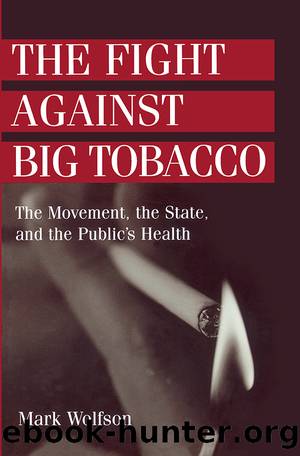The Fight Against Big Tobacco by Mark Wolfson

Author:Mark Wolfson [Wolfson, Mark]
Language: eng
Format: epub
ISBN: 9781351482820
Barnesnoble:
Publisher: Taylor & Francis
Published: 2017-07-12T00:00:00+00:00
Notes
* * *
1 California is an outlier with respect to state monies spent on tobacco control (particularly in the early 1990s). Passage of a voter initiative in 1988 resulted in a very large increase in the state excise tax on cigarettes, a major part of which was devoted to supporting tobacco control efforts at the local level. Subsequently, Massachusetts and Arizona passed similar measures.
2 The seventeen ASSIST states were Colorado, Indiana, Maine, Massachusetts, Michigan, Minnesota, Missouri, New Jersey, New Mexico, New York, North Carolina, Rhode Island, South Carolina, Virginia, Washington, West Virginia, and Wisconsin.
3 In 1999, following the completion of the ASSIST project, major federal tobacco control efforts were consolidated into the National Tobacco Control Program (NTCP), administered by the CDC (USDHHS, 2000). Under this program, all fifty states received awards averaging $1.13 million in fiscal year 2000 (following awards received in fiscal year 1999)ânearly as much as the seventeen ASSIST states received each year during the five-year ASSIST implementation period (USDHHS, 2000).
4 MDH had also been involved since passage of the Minnesota Clean Indoor Air Act in enforcement of the act, as described in Chapter 3.
5 The growing focus on chronic disease had both epidemiologic and economic underpinnings. The United States, like the other industrialized countries, had undergone an âepidemiologic transitionâ in the first half of the twentieth century, reflected in declines in death rates from infectious diseases and increases in death rates from chronic diseases, such as heart disease and cancer (Susser, 1985; Omram, 1971). And the contemporary health education/health promotion movement was a response, in important part, to concerns about uncontrollable medical costs borne by businesses, governments, and individuals (Guinta and Allegrante, 1992).
6 According to some observers, NHLBI was in the forefront of efforts within the NIH to apply and translate scientific knowledge on a broad scale to improve public health. In fact, Blackburn argues that the leadership of NIH in the 1970s did not support applied public health activities on the part of the constituent institutes of NIH (Blackburn, 1983).
7 The choice of the term ânonsmokingâ was deliberate. According to Dean and colleagues (1986:273): âTo provide a positive and somewhat novel perspective, results were structured around nonsmoking whenever possible, presenting potential benefits of nonsmoking rather than the negative impact of smoking. Because nonsmoking was the goal, the epidemiologic and economic projections focused on the results of achieving the goal.â
8 The extent to which the recent focus on youth access to tobacco represents a significantly different way of understanding the issue of youth smoking is illustrated by the treatment of youth access in the Minnesota Plan. All of the key pieces of information that underlie the contemporary focus on youth access were mentioned in the report: The smoking habit usually begins in the childhood and adolescent years (MDH, 1984:89), and restrictions on furnishing tobacco to minors are often not well enforced (ibid.:104). Yet, only one of the recommendations of the planâthat the state should follow Minneapolisâs lead and ban free distribution of cigarettesâaddressed the issue of youth access to tobacco.
Download
This site does not store any files on its server. We only index and link to content provided by other sites. Please contact the content providers to delete copyright contents if any and email us, we'll remove relevant links or contents immediately.
| Adult Children of Alcoholics | Alcoholism |
| Drug Dependency | Gambling |
| Hoarding | Obsessive Compulsive Disorder (OCD) |
| Sexual | Smoking |
| Substance Abuse | Twelve-Step Programs |
The Hacking of the American Mind by Robert H. Lustig(4338)
Right Here, Right Now by Georgia Beers(4167)
Fingerprints of the Gods by Graham Hancock(3964)
Goodbye Paradise(3761)
Bad Pharma by Ben Goldacre(3396)
Happiness by Matthieu Ricard(3018)
More Language of Letting Go: 366 New Daily Meditations by Melody Beattie(3001)
The Social Psychology of Inequality by Unknown(2987)
The Plant Paradox by Dr. Steven R. Gundry M.D(2581)
Drugs Unlimited by Mike Power(2564)
Confessions of a Shopaholic by Sophie Kinsella(2308)
Borders by unknow(2280)
Make Love Not Porn by Cindy Gallop(2080)
Dry by Augusten Burroughs(2072)
Stop Being Mean to Yourself: A Story About Finding the True Meaning of Self-Love by Melody Beattie(1964)
Getting Off by Erica Garza(1910)
Belonging by Unknown(1836)
Yoga and the Twelve-Step Path by Kyczy Hawk(1806)
Unmasking Male Depression by Archibald D. Hart(1782)
